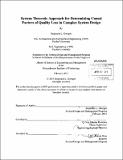System theoretic approach for determining causal factors of quality loss in complex system design
Author(s)
Goerges, Stephanie L
DownloadFull printable version (8.150Mb)
Other Contributors
Massachusetts Institute of Technology. Engineering Systems Division.
Advisor
Qi Van Eikema Hommes.
Terms of use
Metadata
Show full item recordAbstract
Identifying the factors that could lead to the loss of quality is difficult for large, complex systems. Traditional design methods such as Failure Modes and Effects Analysis (FMEA), Fault Tree Analysis (FTA), and Robust Design have been proven effective at the component level but are less effective for factors that involve interactions between components, software flaws and external noises. This thesis applies System Theoretic Process Analysis (STPA) to two case studies at Cummins, Inc. The first case study was a technology change to a subsystem in a new product development project. The intent of this case was to determine if STPA, applied broadly to safety and hazard analysis, would be effective in identifying causes of quality losses. The second case was a historical quality improvement project. The intent of this case was to determine if STPA would be effective for developing solutions to causes of quality losses. The results of the case studies were compared to the traditional design methods. Use of STPA allowed the design teams to identify more causal factors for quality losses than FMEA or FTA, including component interactions, software flaws, and omissions and external noises. STPA was also found to be complementary to Robust Design Methods. Finally, use of STPA was effective for analyzing the complete hierarchical structure of the system for solutions to potential causes of quality losses.
Description
Thesis (S.M.)--Massachusetts Institute of Technology, Engineering Systems Division, 2013. Cataloged from PDF version of thesis. Includes bibliographical references (p. 105-109).
Date issued
2013Department
Massachusetts Institute of Technology. Engineering Systems DivisionPublisher
Massachusetts Institute of Technology
Keywords
Engineering Systems Division.